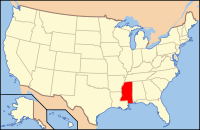Panola County, Mississippi
| Panola County, Mississippi | |
|---|---|

Panola County Courthouse
|
|
 Location in the U.S. state of Mississippi |
|
 Mississippi's location in the U.S. |
|
| Founded | February 9, 1836 |
| Seat | Batesville and Sardis |
| Largest city | Batesville |
| Area | |
| • Total | 705 sq mi (1,826 km2) |
| • Land | 685 sq mi (1,774 km2) |
| • Water | 20 sq mi (52 km2), 2.8% |
| Population | |
| • (2010) | 34,707 |
| • Density | 51/sq mi (20/km²) |
| Congressional district | 2nd |
| Time zone | Central: UTC-6/-5 |
| Website | www |
Panola County is a county located in the U.S. state of Mississippi. As of the 2010 census, the population was 34,707. Its county seats are Sardis and Batesville. Panola is a Cherokee word which means cotton. The county is located just east of the Mississippi Delta and bisected by the Tallahatchie River flowing to the southwest, separating the two county seats.
Panola County was established February 9, 1836, and is one of the twelve large northern Mississippi counties created that year from the territory of the Chickasaw Cession of 1832. The original act defined its limits as follows:
Beginning at the point where the line between ranges 9 and 10 strikes the center of section 6, and running thence south with the said range line, and from its termination in a direct line to the northern boundary of Tallahatchie County and thence along the northern boundary of Tallahatchie and Yalobusha counties, to the center of range 5 west; thence north through the center of range 5 west, according to the sectional lines, to the center of township six; thence west through the center of township six, according to the sectional lines, to the beginning.
On February 1, 1877, when Quitman County was organized by the legislature, it took a small fraction of Panola's southwestern area, reducing Panola from an area of 756 square miles (1,960 km2) to its present land surface of 705 square miles (1,830 km2). The county had a population of 27,845, in 1920. Its inhabitants gradually increased in numbers from 1850 to 1910, from 11,444 to 31,274, reaching a peak of population in 1940. From then until 1980, population declined markedly, as many African Americans moved west and north in the second wave of the Great Migration, to take jobs on the West Coast in the burgeoning defense industry.
...
Wikipedia
